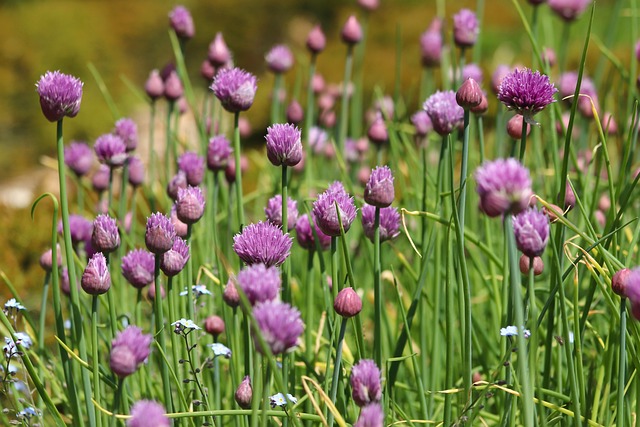Introduction:

Chives are one of the easiest herbs to grow. I have them planted in several places and so far they have come back every year with no particular help from me! These versatile and easy-to-grow herbs are not only delicious but also make a stunning addition to any herb garden. In my comprehensive guide, we’ll delve into the art of growing chives, providing you with valuable insights, tips, and techniques to help you cultivate vibrant chive plants that will elevate your cooking to new heights.
Choosing the Right Location
Chives thrive in well-drained soil and require ample sunlight. Find a spot that receives at least six hours of direct sunlight per day. Ensure the soil is fertile and well-draining, as chives prefer slightly moist conditions but don’t tolerate waterlogged roots.
Most vegetables’ do well in these conditions, but frankly, I have a patch of chives I don’t even remember planting, growing my my native soil on a swale. My soil, when dry, is like concrete. But my chives came back bushy and healthy even so.
Planting Chives
When it comes to planting chives, you have two primary options: sowing seeds or transplanting young chive plants. If sowing seeds, prepare the soil by loosening it and removing any weeds. Sow the seeds about ¼ inch deep and cover lightly with soil. Water gently and keep the soil consistently moist until germination occurs. Alternatively, you can purchase young chive plants from a nursery and transplant them directly into your garden. I’ve had better luck with nursery seedlings. Keep in mind you can divide chives every few years and get more plants that way.
Nurturing and Care
Chives are relatively low-maintenance herbs. Here are some tips to keep in mind, to help them thrive:
Watering
Chives prefer evenly moist soil, so water them regularly, especially during dry spells. Be cautious not to overwater, as excessive moisture can lead to root rot. My chives have made it through two hot dry summers with little attention from me but I’m sure they’d do even better with watering.
Fertilization
Chives benefit from a balanced fertilizer application once or twice during the growing season. Use a slow-release organic fertilizer to provide them with the necessary nutrients.
Pruning
Regularly snip off the flower heads to encourage continuous leaf growth. Additionally, trim the leaves when needed for culinary use, ensuring not to remove more than one-third of the plant at a time. This is a cut and come back plant! Don’t you love those?
Harvesting Chives
The best part of growing chives is savoring the fruits of your labor. Once your chive plants have reached a height of around 6 inches, you can start harvesting the leaves. Simply snip off the desired amount of chives near the base of the plant, making sure not to remove all the leaves at once. This allows the plant to continue growing and producing fresh leaves throughout the season.
Culinary Uses
Chives lend a wonderful onion-like flavor and vibrant green color to a wide array of dishes. From soups and salads to creamy dips and garnishes, these versatile herbs are a chef’s dream. Chop them finely and sprinkle over your favorite recipes to add a burst of freshness. Chive blossoms can also be used as edible decorations, providing an eye-catching touch to your culinary creations.
The Perennial Nature of Chives
Unlike many other herbs, chives will come back year after year, providing a continuous supply of fresh leaves for your culinary endeavors. This perennial growth habit makes chives an excellent long-term investment for your garden.
By establishing a healthy chive plant, you can enjoy its flavorful leaves for several years without the need for replanting. This makes chives a convenient choice for gardeners who want a sustainable herb crop that requires minimal effort.
Dormancy
As a perennial herb, chives go through a dormant phase during the winter months. The leaves may die back, but the plant remains alive beneath the soil’s surface, ready to sprout new growth when the warmer seasons return. This resilience and ability to withstand colder temperatures make chives suitable for a wide range of climates.
Longevity
To ensure the longevity of your chive plants, it helps to provide them with proper care. Regular watering, well-draining soil, and occasional fertilization will help maintain their vigor. Divide mature clumps every two to three years to prevent overcrowding and encourage healthy growth. This article belong to pineyriverhomestead.com published 9-18-23
The perennial nature of chives also presents an opportunity for propagation. Once your chive plants have established themselves, you can divide them into smaller sections and replant them in different areas of your garden or share them with fellow gardeners. This method of propagation ensures a constant supply of chives in multiple locations.
Because chives are perennial they are a sustainable and reliable herb harvest year after year. By understanding their growth pattern and providing appropriate care, you can enjoy the fresh, onion-like flavor of chives in your culinary creations for seasons to come.
Chives as Companion Plants:
Chives not only enhance your culinary experience but also serve as excellent companion plants in the garden. Companion planting involves strategically growing certain plants together to maximize their growth, health, and overall garden productivity. Here’s how I use chives alongside other plants:
- Pest Control: Chives possess natural pest-repellent properties that can help protect neighboring plants. The strong aroma of chives deters pests such as aphids, carrot flies, and Japanese beetles. I plant chives near susceptible plants to create a barrier and help reduce the risk of pest infestations.
- Attracting Beneficial Insects: Chive flowers are highly attractive to beneficial insects like bees, butterflies, and hoverflies. These insects assist in pollination and prey on harmful garden pests. By attracting beneficial insects, chives contribute to a healthier and more balanced ecosystem in your garden.
- Shade and Protection: Chives’ upright growth habit and slender leaves can provide shade and protection to more delicate plants. When planted strategically, chives can shield sun-sensitive plants from excessive heat and sunburn, creating a more favorable microclimate for their growth.
- Nutrient Accumulation: Chives belong to the Allium family, known for their ability to accumulate sulfur in the soil. Sulfur is essential for plant growth and helps enhance the flavor and quality of vegetables. Planting chives alongside sulfur-loving plants like tomatoes and peppers can provide them with an extra dose of this beneficial nutrient.
Plants that Thrive when Grown Alongside Chives:
- Tomatoes: Chives and tomatoes make great companions. Chives help repel pests like aphids and protect tomatoes from fungal diseases. Additionally, chives’ sulfur content can enhance the flavor and growth of tomatoes.
- Carrots: Chives and carrots have a mutually beneficial relationship. Chives deter carrot flies, which can damage carrot crops. The scent of chives masks the smell of carrots, making them less attractive to these pests.
- Brassicas: Chives can be planted near cabbage, broccoli, and other brassica family plants. They repel common pests like cabbage worms and aphids, reducing the need for chemical interventions.
- Roses: Chives can be a fantastic companion for roses. Their pungent smell helps repel aphids, which are notorious for attacking roses. Planting chives at the base of rose bushes can provide a natural defense against these pests.
- Strawberries: Chives and strawberries make a compatible pair. Chives deter slugs and snails, common pests that can damage strawberry plants. Additionally, chives’ flowering stage attracts pollinators, ensuring better fruit set for strawberries.
Remember that while companion planting can provide numerous benefits, it is crucial to consider the specific needs of each plant, including sunlight requirements, spacing, and soil preferences. Observing how different plant combinations interact in your garden will help you discover the most successful companion plant pairings.
Incorporating chives as companion plants can contribute to a healthier, more diverse, and productive garden, benefiting both your culinary endeavors and overall gardening experience.
Conclusion:
So there you have it! Growing chives is a rewarding experience that brings both visual appeal and delectable flavor to your kitchen. By following the tips and techniques outlined in this guide, you can cultivate robust chive plants that will thrive in your herb garden. So, get ready to embark on a journey of flavor and elevate your dishes with the delightful taste of homegrown chives. Happy growing and happy cooking!

For more about growing herbs and being self-sufficient click here.
